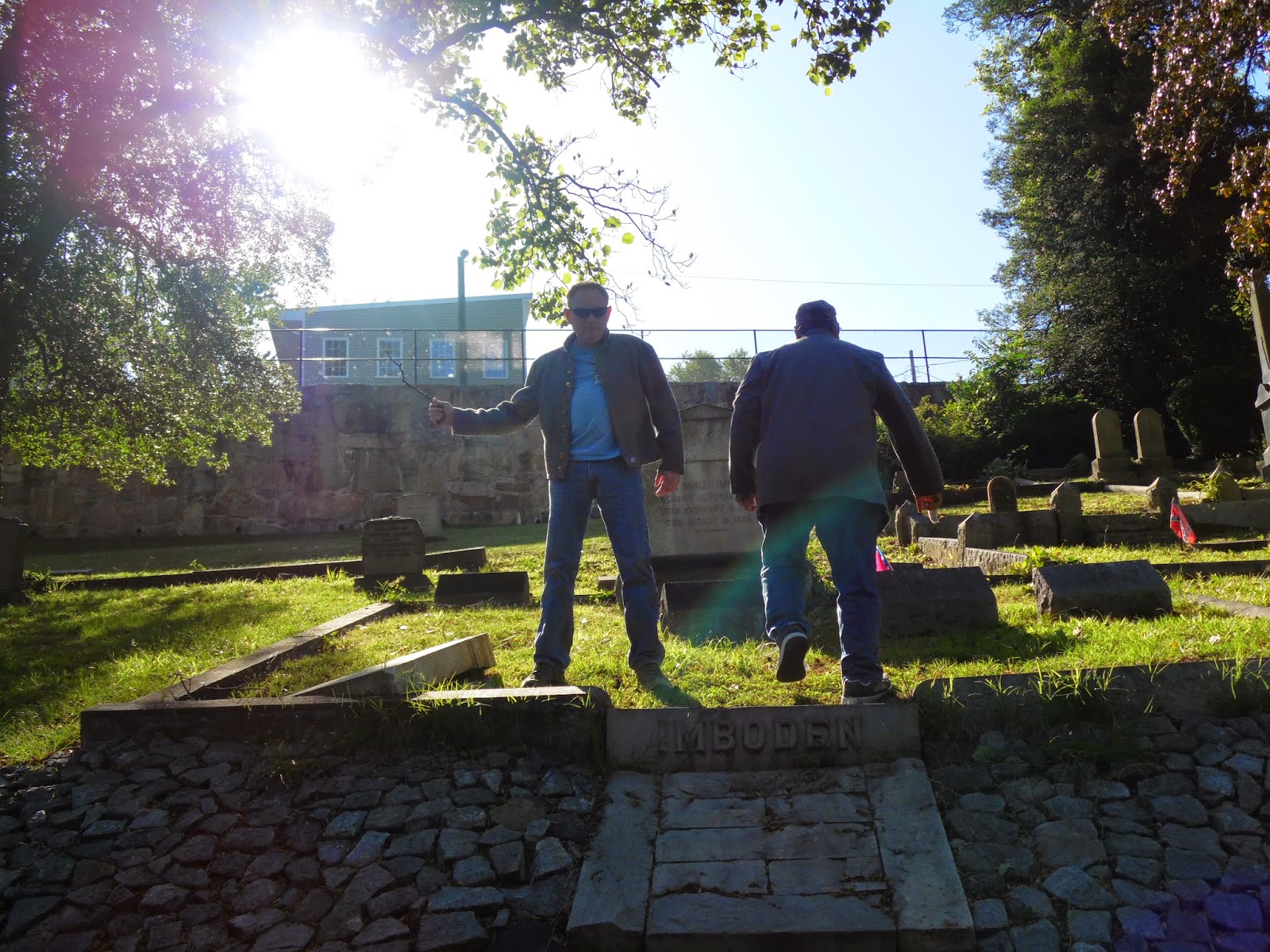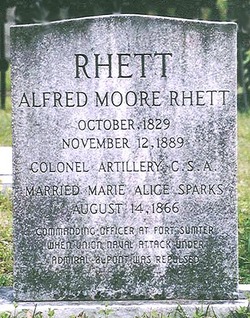Home of the Richmond Vampire in Hollywood Cemetery
We left Charlottesville, Virginia for Richmond at dark on Friday night and arrived about bedtime in Richmond. The next morning would give us a bunch of generals for our scrapbook. When Jerry and I began our hobby of getting our photographs made with Confederate generals, I wasn't sure how I would display them. A trip to Corinth, Mississippi a month ago to see my buddy Shirley McKenzie would solve that problem for me. She had a scrapbook that she made that showed pictures of her family. When we left, I told my wife that Shirley gave me an idea and we immediately went to Hobby Lobby where we purchased a scrapbook to begin my photo's of me and Confederate generals. I can't wait to show my book to Shirley the next time we meet.
Me and Jerry with Lieutenant General A.P. Hill
The next morning we struck out for the grave of Lieutenant General Ambrose Powell Hill who happens to be buried in the middle of a Richmond intersection. Jerry had promised me several times that the intersection is not very busy because he had passed through this place before. I was convinced that a Saturday morning about 8 a.m. would be the perfect time to visit a "not very busy" intersection. We arrived to find it extremely busy. I told Jerry that we would be ran over and placed in the Richmond paper obituary. Melanie refused to get out of the van. She kept saying, "This is crazy" as she watched the traffic fly by. Stacie positioned herself in the perfect position to take our picture as we darted across the road amid the traffic. It reminded me of a real life game of "Frogger" as we dashed past flying automobiles. Upon returning to the van, Melanie mentioned a guy stopped at the red light who picked up his phone to report us to someone. A.P. Hill became a corps commander under General Robert E. Lee. Legend has it that he is buried standing up in the center of the intersection. I need to do more research on General Hill to learn why.
We left Hill's grave and went to Shockhoe Hill Cemetery where we got photographed at the grave of Brigadier General Patrick Theodore Moore. Moore was so severely wounded at Manassas that he was unable to take field command for the remainder of the war. The neighborhood around Shockhoe Hill made our wives feel very uncomfortable about getting out of the van, but of course Jerry and I pressed on.
At least there was a police department across the street from Shockhoe Hill
We left Shockhoe Hill and proceeded to Hollywood Cemetery which is known as the "Arlington of the Confederacy." This cemetery contains the graves of 17,000 Confederate soldiers (along with the Gettysburg dead) and possibly 27 Confederate generals. (More on the possibly 27 as we go along).
We entered Hollywood (named Hollywood because of all the Holly trees located there) and found the office was closed on Saturday. I was already concerned about finding all the generals, but became more so when I realized we couldn't purchase a map without the office being open. Melanie is not at all bashful and saved us on this trip. She found a lady that worked as a caretaker in the cemetery and asked her for a map. She drove back to the office and located us a small cemetery map which saved the day. On the drive up, Jerry had printed off a list of all 26 Confederate generals buried at Hollywood (notice I said possibly 27 in the prior paragraph). I told him we would get 27 generals on our visit to Hollywood, the reason being that the body of Brigadier General Richard Brooke Garnett was never found and buried alongside the rest of his troops. People often look at the paintings of generals in their dress coats leading charges, but this rarely happened during the war. General Garnett led his brigade in Pickett's Charge wearing only a plain blue coat. Therefore, when he was killed by canister fire (his body was possibly ripped to shreds) he was unidentified and buried alongside his men. When the Confederate soldiers were dug up and re-interred in Hollywood Cemetery following the war, General Garnett was most likely removed with his men and rests today in an unmarked grave there. Therefore, the only way for Jerry and I to get our pictures made with Garnett is beside the marker in his memory amid his men in Hollywood and that's what we did.
The first general we located was Brigadier General John Daniel Imboden who had commanded artillery at Manassas and cavalry for the remainder of the war. It was at this grave that Stacie decided the grass was too high for a quality photo. Jerry bent over pulling up weeds while I found a switch and attempted to spank him, but he moved too quickly for me. It seems he probably spent the early part of his childhood avoiding spankings by the speed in which he got away from me.
Me trying to spank the Ole Man
Although, I had visited Hollywood Cemetery back in 1996, I had trouble finding Garnett's stone because Melanie had to use the bathroom so bad, she couldn't wait for the woman to open the bathroom (it was locked). I had to avert my eyes and search for the grave because she was behind a small shrub with a small napkin in her hand. Luckily, Jerry found the grave for me.
Jerry and I with the marker for Richard Brooke Garnett
We quickly found the graves of Confederate general's Edward Johnson (Major General of Virginia), David Rumph Jones (Major General of South Carolina), and Brigadier General John Caldwell Calhoun Sanders (Brigadier General of Alabama) in the Confederate officers section. Actually, General Sanders grave site has been lost and the marker is somewhere near his actual grave. We then ran into a snag with the grave site of Brigadier General Walter Husted Stevens. The map shows him alongside of the three generals in the officers section, but he was no where to be found. At this point, I was extremely glad that Melanie had the lady unlock the bathroom doors because I had an emergency. We raced back to the office and I raced into the restroom. When I exited the bathroom, I jumped in the van and began to head back toward the cemetery. Melanie screamed at me to stop. I hadn't noticed, but my wife had gotten out of the van and went to the bathroom and I was about to leave her at the cemetery entrance.
We drove back down the hill and Jerry and I quickly found General Stevens. We jumped out and had our photo's taken with him before continuing our search.
Brigadier General Walter Husted Stevens
Things began to get even more goofy from here on out for our visit to Hollywood Cemetery. We then began to search for the grave of one of my personal hero's Brigadier General William Edwin Starke who was killed at the battle of Antietam while serving under Stonewall Jackson. We approached the area where Starke is buried and found the ghost dog of Hollywood Cemetery. This dog is supposed to come alive at night as it guards the grave of a girl who died during the Civil War at a very young age. We got pictures of both Stacie and Melanie petting the dog. Both said they almost cried as they put their hands on the dogs head.
Mel with the ghost dog
Stacie with the ghost dog
Jerry and I quickly located the grave of General Starke and had our picture made. It was when we returned to the van that we had a moment of disbelief. Melanie's maiden name is Turpin and she found a man buried in the cemetery that was a Turpin. When we returned, she was busy pushing buttons on her phone. The following is what I heard her saying:
Melanie: "That's the strangest phone number I've ever seen, but I gotta call him and see if we are related. One eight zero seven dash one eight seven four."
Me: "What are you doing Melanie?"
Melanie: "Trying to find out if I'm related to this man."
Jerry: "Do you see what I have to put up with every day?"
Tim: "Mel, that is not his cell number, it's his birth and death dates."
Melanie: "Well, no wonder he won't answer his phone."
Jerry (shaking his head as usual): "I told you I didn't have very far to drive when I drove her crazy."
Tim: "Mel, how were you going to call a dead guy and expect him to answer the phone?"
Melanie: "I don't want to hear no more from you or you brother, just shut up."
Ole Man and me with General William E. Starke
The rest of Hollywood Cemetery coming up tomorrow...





































